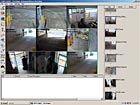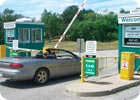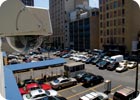Parking ‘Lots’ of Trouble


Security video for St. Louis Parking, with more than 100 facilities and handling in excess of 40,000 vehicles daily, focuses on convenience, efficiency, cleanliness and safety.
Parking Today, a trade publication, reports that there are more parking structures with higher technology security solutions. Among the top tech – security video, sometimes with license plate recognition; access control readers tied into gates; emergency telephones; and security officers on patrol on parking lots and in parking garages.
Security liability expert Norman Bates consistently reports that negligent security lawsuits are more often related to incidents in parking lots and garages.
For people using parking facilities, the most numerous complaints center on poor lighting, difficult access and lack of signage.
The Zalud Report sought workable solutions within the industry.
For example, St. Louis Parking, the oldest and largest parking company in the region, has more than 100 facilities capable of housing in excess of 40,000 vehicles daily. It focuses on convenience, efficiency, cleanliness and safety. In addition to customer safety and fighting break-ins, theft and vandalism, the firm sought a security solution that would track parking capacity as well as monitoring of employees.
The solution from Arteco hit four end-user needs.
- A violated area application detects entry in restricted areas in real-time.
- Direction detection alerts when vehicles move incorrectly through one-way paths.
- Loitering persons in a parking facility are detected and alert to security officers.
- Each vehicle entering or leaving the facility is recorded as a “time-stamped” image.

At the Toronto Zoo, Canadian Parking Equipment uses a contactless smart card system to simplify entry and enhanced facility auditing and payment efficiencies at surface lots.
Using secure, contactless smart card technology, the Toronto Zoo, Canada’s premier zoo, now better serves over 1.2 million visitors a year in a very busy parking operation with over 250,000 vehicles. The zoo selected the smart cards to alleviate long parking lines. The reusable cards allow the zoo to audit the number of visitors and collect parking fees upon exiting. Zoo members with prepaid parking passes, and visitors who are provided with contactless smart cards upon entrance, pay for parking at readers upon completion of their visit rather than at entry. At the end of each day, staff members retrieve the collected cards from the terminals for redistribution the following day.
In addition to efficient trafficking, the cards are also highly waterproof, a key requirement as one of the popular areas at the zoo is a water park.

InterPark has installed an integrated security solution at one of its many facilities in Philadelphia, Pa. It includes audio intercom, security video and entrance/exit gate control with the ability to interface with revenue control systems.
There are more integrated solutions on the market, according to Bob Johnson, director of location services for InterPark.
He found value in Honeywell’s ParkMAXX, which combines the functions of audio intercom, security video and entrance/exit gate control with the ability to interface with revenue control systems. With a patron on one end of an intercom and an attendant at the other, both garage owners and operators benefit from the ability to assign a decision code to each transaction. Parking owners can realize significant cost savings and marked revenue increases in their facilities as a result of better information about daily operations.
“We searched for an integrated audio, video and revenue control interface that would meet the needs of our business,” said Johnson. InterPark has installed ParkMAXX at one of its many facilities in Philadelphia, Pa. After the first six months of the installation, the garage realized a seven percent increase in revenue.
Looking for a reprint of this article?
From high-res PDFs to custom plaques, order your copy today!







